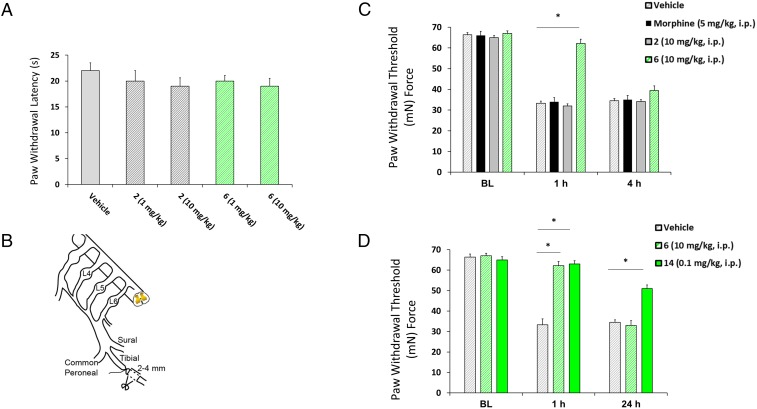Fig. 5.
Compounds 6 and 14, but not 2, reverse mechanical hypersensitivity in the TNI model of neuropathic pain. (A) Bar graph of paw withdrawal latency (in seconds) of rats (n = 6 per group) demonstrating a lack of analgesic effect for 2 or 6. (B) Diagram of the sural, tibial, and common peroneal terminal nerve branches of the sciatic nerve and their dorsal root origins. Neuropathic pain was induced by ligation of the tibial nerve, and 2–4 mm of the nerve distal to the ligation was removed. (C) PWT (in milli-Newtons, mN) in response to von Frey stimulation to the paw ipsilateral to injury following a single i.p. administration of vehicle, morphine (5 mg/kg), 2, or 6 (10 mg/kg, n = 8) at 4 wk after TNI. The ability of 6 (green striped bar) to reverse TNI-induced mechanical hypersensitivity was significantly different from that of 2 (solid gray bar) and morphine (black striped bar). *P < 0.05 versus 2 and morphine treatment in TNI rodents (mean ± SE; n = 8, repeated measures ANOVA with Tukey’s post hoc test). BL, baseline. (D) At 4 wk, a single bolus injection of 14 (0.1 mg/kg) significantly reversed mechanical hypersensitivity at both 1 and 24 h post dosing. For comparison, reversal of mechanical hypersensitivity by 6 (10 mg/kg) was limited to 1 h. Data are shown as mean ± SE; n = 8; *P < 0.05 versus 6 and vehicle-treated TNI rodents; repeated-measures ANOVA with Tukey’s post hoc test.

